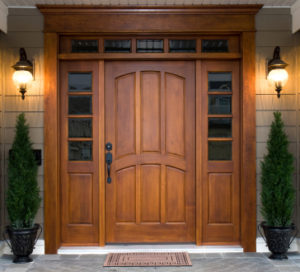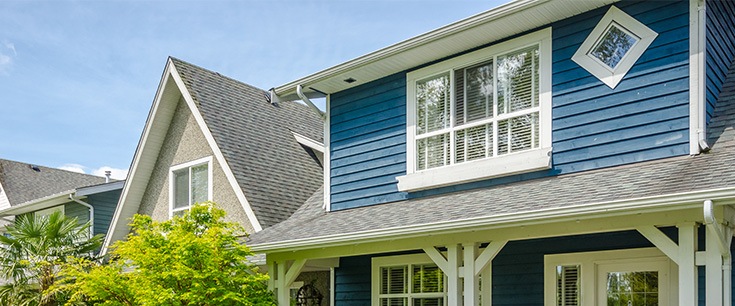Stained Entry Doors
Entry doors are exposed to the changing seasons, from heavy rain to hot temperatures. Choosing a front door that can withstand the elements while retaining its appeal and functionality is essential. Our entry doors at See-Thru Windows, Doors & Bathroom Remodeling are custom finished with various stains and paints that enhance their longevity and keep them as beautiful as the day we install them.
How Our Stains and Paints Protect Entry Doors
At See-Thru Windows, Doors & Bathroom Remodeling, we offer 20 decorator color options, enabling you to match your entry door to the aesthetic of your home. We also have seven custom front door stains and paints. Whether you want paint that protects against UV rays or moisture, we have options to suit your needs.

Our stains and paints provide your exterior door with an extra surface layer of protection that acts as the first point of contact between the elements and the material of the door. Staining your front door gives it a quality seal that can make it more durable and long-lasting.
Why Choose Our Entry Door Stains and Paints?
We make finding the perfect door for your home a stress-free process. Our quality-crafted doors are hand-stained with various finishes to enhance and preserve the visual appeal while providing the necessary protection. Here are some of the benefits of our exterior door paints and stains:
- GuardCoat Seal: All the various stained entry doors we offer are stained with GuardCoat Seal, which ensures the door preserves its beauty over time.
- Quality exterior door paint: We use bake-on, high-quality exterior door paint on all steel doors, which are zinc-galvanized and primed.
- Stunning stains: The right stain finish can significantly improve the look of your door. You can choose from our seven finishes that are hand-stained for your entry door, providing an authentic wooden look.
- Embossed Woodgrain: You can emboss your fiberglass or steel doors with a wood grain to give them a finish and textured surface that resembles natural wood.
- Longevity: All our entry doors have an exclusive seven-year warranty on all finishes.
To effectively prepare and apply wood stain, follow these best practices:
Preparing the Wood for Staining:
1. **Cleaning:** Begin by thoroughly cleaning the wood to remove any dust and debris. A stiff nylon brush is ideal for this task.
2. **Sanding:** Smooth the wood surface using fine-grit sandpaper. This not only helps in creating a uniform texture but also enhances stain absorption evenly. Keep in mind that rougher surfaces can absorb more stain and appear darker.
3. **Wiping:** Once sanded, wipe down the wood with a clean, dry cloth to remove any residual dust from sanding. This ensures a clean surface for better staining results.
Applying the Wood Stain:
1. **Choosing the Right Stain:** Select a wood stain that suits your project — consider the wood type and desired finish. Each type of stain differs in terms of application techniques and the final look it provides.
2. **Reading Instructions:** Always read the manufacturer’s instructions before starting. Different stains might require different application tools like brushes, rags, or sprayers.
3. **Staining Process:** Apply the stain using the appropriate method advised for your chosen product. Ensure even coverage to avoid blotches and uneven tones.
4. **Drying and Curing:** After application, allow the stain to dry as recommended. Avoid touching or using the stained wood until it has fully cured, which could take longer than the initial dry time.
By adhering to these steps, you can achieve a professional and durable finish on your wood staining project.
Contact Us for Stained Entry Door Installation
See-Thru Windows, Doors & Bathroom Remodeling offers high-quality stained doors in Waldorf and other surrounding areas in Maryland and Virginia. We have decades of experience and can provide you with the best solutions. Our team will work with you and help you choose the suitable doors, stains and colors for your specific needs.
For custom stained front doors, contact us to get started.
Frequently Asked Questions:
How can wood stain be used to transform living spaces and preserve wooden furniture?
Wood stain offers a dual benefit for home improvement. Firstly, it serves as a protective layer that extends the life and beauty of wooden surfaces and furniture by guarding against wear and damage. Secondly, wood stain can revitalize a room’s appearance by enhancing the natural grain of wood and introducing rich new hues that complement your existing décor. This means you can alter the ambiance and aesthetic of your living spaces without the need to invest in new furniture, ensuring both preservation and transformation efficiently.
What is unique about water-soluble dye stains and how are they different from other types of stains?
Water-soluble dye stains are distinct in their formulation and application method compared to other wood stains. They are typically sold in a powdered form that can be dissolved in water, allowing users to easily control the intensity of the stain by adjusting the amount of powder used. This feature is particularly favorable for novice woodworkers as it simplifies the process of achieving a desired color depth. Unlike many other stains, water-soluble dye stains do not contain a binding agent, which means the color can be modified even after application to the wood. This type of stain also permits varying levels of color saturation without masking the natural grain and texture of the wood. However, it is important to note that water-soluble dye stains are more vulnerable to fading when exposed to ultraviolet light. This sensitivity necessitates careful consideration about where items treated with this stain will be placed, or the application of a protective topcoat to shield against UV rays.
What are the characteristics of lacquer-based wood stains and how do they differ from other types of stains?
Lacquer-based wood stains can be identified by the presence of ketones and xylene in their ingredients list. These chemicals enable the stain to adhere seamlessly to surfaces already coated with lacquer, allowing for modifications in coloration between different layers of finish. A significant advantage of using lacquer-based stains is their rapid drying time, which is typically around 15 minutes. This feature is highly valued by professionals as it allows for faster completion of projects, providing better control over the final color outcome. However, the quick-drying nature and the complex interaction with lacquer finishes make these stains more challenging to use, suggesting that application by a pair of hands—working collaboratively—might yield the best results. In contrast, other types of stains usually dry slower and may not require such coordination or specific chemical properties for effective application.
What is the purpose of gel-based wood stains, and for which type of wood are they particularly recommended?
Gel-based wood stains are designed to mitigate the common issue of blotching that occurs when staining certain types of wood, such as pine. Their thicker consistency allows for a more uniform application without the need for a washcoat or wood conditioner, which are typically used to prepare the wood surface before staining. This makes gel stains particularly effective and convenient for woods that tend to absorb stains unevenly, allowing for a smoother and more consistent finish without the additional preparatory steps
How do oil-based wood stains differ from water-based wood stains in terms of application and characteristics?
Oil-based wood stains and water-based wood stains differ in several important ways, particularly in terms of their application processes and inherent characteristics. Oil-based stains typically consist of a mixture that includes paint thinner, also known as mineral spirits, aliphatic hydrocarbons, or petroleum distillates. These components are effective for both thinning the stain and cleaning up after application, but they come with certain drawbacks. Notably, oil-based stains emit potent fumes, are flammable, and present challenges in terms of safe and environmentally friendly disposal. When working with such stains, it’s crucial to operate in a well-ventilated area, ideally outside of living spaces, to reduce the risk of inhaling toxic fumes or accidentally igniting flammable materials. In contrast, water-based stains are generally more user-friendly, especially in environments within homes. They are noticeably less noxious, as they emit fewer odorous fumes and involve less chemical exposure, making them less hazardous to apply in terms of personal health and safety. Cleanup after using water-based stains is also more straightforward, usually requiring only soap and water. Furthermore, these stains are more environmentally benign, contributing less pollution. However, applying water-based stains has its unique challenges. When applied, water-based stains tend to cause the wood’s grain to swell or ‘raise.’ This effect requires additional sanding between coats to achieve a smooth finish. Water-based stains also dry much faster than oil-based stains, which can complicate the application process as it allows less time to even out the stain before it sets, requiring more precise and quick work during application. Overall, the choice between oil-based and water-based wood stains will largely depend on the specific needs of the project, considering factors like the desired finish, the working environment, and health and safety issues.
What are the different types of wood stains available for homeowners to choose from?
When exploring the variety of wood stains available on the market, homeowners have a wide selection to consider, each offering unique characteristics and finishes. The options include: 1. Stains based on oil, which penetrate deeply into the wood to provide rich color. 2. Stains that are water-based, known for their eco-friendliness and ease of use. 3. Gel stains, which are thicker and ideal for use on vertical surfaces as they don’t drip. 4. Stains derived from lacquer, which dry quickly and offer a durable finish. 5. Varnish stains that combine stain and finish for a two-in-one solution. 6. Dye stains that are water-soluble, offering intense color saturation. 7. Metalized dye stains, which provide long-lasting color and are often used in commercial applications. Each type of stain has its own set of benefits, allowing for personalization of projects based on the desired aesthetic and functional outcomes.
How can Plastpro’s staining kits be beneficial for staining projects, and what advantages do they offer compared to traditional wood stains?
Plastpro’s staining kits are highly beneficial for staining projects as they are comprehensive, including all the necessary tools and materials required to complete the task effectively. These kits are particularly advantageous as they come with detailed guides that offer step-by-step instructions and tips on how to achieve various finishes and aesthetics. This can be especially helpful for beginners or those unfamiliar with staining techniques. Furthermore, unlike traditional wood stains that are designed specifically for wood surfaces, Plastpro’s stains are suitable for fiberglass doors. This allows users to apply a wood-like finish to fiberglass, broadening the scope of design possibilities and enabling homeowners to seamlessly integrate their doors with other wooden elements in their homes. By choosing from a range of fiberglass door stain colors, one can easily customize and enhance the appearance of their doors to match their overall home décor.
What are metalized dye stains, and how do they address the UV light sensitivity seen in water-soluble dye stains?
Metalized dye stains are a type of wood stain developed specifically to address the issue of UV light sensitivity found in water-soluble dye stains. Unlike their predecessors, these stains incorporate metallic components that significantly increase their resistance to ultraviolet light exposure from sources such as the sun and fluorescent lights. This makes them a more durable option for projects that are exposed to light. Additionally, metalized dye stains have a quicker drying time and are often applied by spraying onto the wood surface. While they can be diluted with water, doing so may lead to grain-raising issues, which is a common problem with water-based stains.




